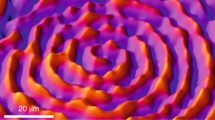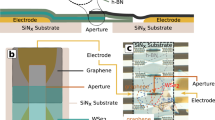Abstract
The environmental scanning electron microscope (ESEM) is a direct descendant of the conventional SEM, but also permits wet and insulating samples to be imaged without prior specimen preparation. A low pressure (up to around 10 torr) of a gas can be accommodated around the sample. When this gas is water, hydrated samples can be maintained in their native state. Whether the gas is water or some other gas, ions formed on collisions between electrons emitted from the sample and the gaseous molecules drift back towards the sample surface helping to reduce charge build up. This eliminates the need for insulators to be subjected to a conductive surface coating. These two key advantages of ESEM open up a wide range of materials to the power of scanning electron microscopy.
This is a preview of subscription content, access via your institution
Access options
Subscribe to this journal
Receive 12 print issues and online access
$259.00 per year
only $21.58 per issue
Buy this article
- Purchase on Springer Link
- Instant access to full article PDF
Prices may be subject to local taxes which are calculated during checkout






Micrograph courtesy of A. J. Ryan and C. Salou, University of Sheffield, UK.
Similar content being viewed by others
References
Danilatos, G.D. Foundations of environmental scanning electron microscopy. Adv. Electron. El. Phys. 71, 109–250 (1988).
Meredith, P., Donald, A.M. & Thiel, B. Electron-gas interactions in the environmental SEM's gaseous detector. Scanning 18, 467–473 (1996).
Uwins, P.J.R. Environmental scanning electron microscopy. Mater. Forum 18, 51–75 (1994).
Schalek, R.L. & Drzal, L.T. Characterisation of advanced materials using an environmental SEM. J. Adv. Mater. 32, 32–38 (2000).
Maroni, V.A., Teplitsky, M. & Rupich, M.W. An ESEM study of the Ag/Bi-2223 composite conductor from 25–840 C. Physica C 1999, 169–174 (1999).
Kjellsen, K.O. & Jennings, H.M. Observations of microcracking in cement paste upon drying and rewetting by environmental scanning electron microscopy. Adv. Cem. Based Mater. 3, 14–19 (1996).
Huggett, J.M. & Uwins, P.J.R. Observations of water-clay reactions in water-sensitive sandstone and mudrocks using an ESEM. J. Petrol Sci. Eng. 10, 211–222 (1994).
Schmid, B., Aas, N. & Odegard, G. High-temperature oxidation of nickel and chromium studies with an in-situ environmental scanning electron microscope. Scanning 23, 255–266 (2001).
Cameron, R.E. & Donald, A.M. Minimising sample evaporation in the ESEM. J. Microsc. 173, 227–237 (1994).
Royall, C.P. The Behaviour of Silica in Matt Water-based Lacquers. Thesis, Cambridge Univ. (2000).
Lange, D.A., Sujata, K. & Jennings, H.M. Observations of wet cement using electron microscopy. Ultramicroscopy 37, 234–238 (1991).
Neubauer, C.M. & Jennings, H.M. The role of the ESEM in the investigation of cement-based materials. Scanning 18, 515–521 (1996).
Meredith, P., Donald, A.M. & Luke, K. Pre-induction and induction hydration of tricalcium silicate: an environmental scanning electron microscopy study. J. Mater. Sci. 39, 1921–1930 (1995).
Stark, J., Mosser, B. & Eckart, A. New approaches to cement hydration, part 2. ZKG Int. 54, 114–119 (2001).
Rodriguez-Navarro, C., Doehne, E. & Sebastian, E. How does sodium sulfate crystallize? Implications for the decay and testing of building materials. Cement Concrete Res. 30, 1527–1534 (2000).
Keddie, J.L., Meredith, P., Jones, R.A.L. & Donald, A.M. Kinetics of film formation in acrylic latices studied with multiple-angle-of-incidence ellipsometry and environmental SEM. Macromolecules 28, 2673–2682 (1995).
Keddie, J.L., Meredith, P., Jones, R.A.L. & Donald, A.M. Film formation of acrylic latices with varying concentrations of non-film forming particles. Langmuir 12, 3793–3801 (1996).
Donald, A.M. et al. Application of ESEM to colloidal aggregation and film formation. Colloids Surf. A 174, 37–53 (2000).
Miller, A.F. & Cooper, S.J. In situ imaging of Langmuir films of nylon 6–6 polymer using ESEM. Langmuir 18, 1310–1317 (2002).
Jenkins, L.M. & Donald, A.M. Condensation of water droplets onto individual fibres for contact angle measurement in the ESEM. Langmuir 15, 7829–7835 (1999).
Nitz, H., Semke, H. & Mulhaupt, R. Influence of lignin type on the mechanical properties of lignin based compounds. Macromol. Mater. Eng. 286, 737–743 (2001).
Gu, H., Zink-Sharp, A. & Sell, J. Hypothesis on the role of cell wall structure in differential transverse shrinkage of wood. Holz Roh Werkst. 59, 436–442 (2001).
George, J., Klompen, E.T.J., & Peijs, T. Thermal degradation of green and upgraded flax fibres. Adv. Comp. Lett. 10, 81–88 (2001).
Jenkins, L. & Donald, A.M. Use of the ESEM for the observation of the swelling behaviour of cellulosic fibres. Scanning 19, 92–97 (1997).
Cameron, R.E., Durrani, C.M. & Donald, A.M. Gelation of amylopectin without long range order. Stärke 46, 285–297 (1994).
Darkin, M., Gilpin, C., Williams, J. & Sangha, C. Direct wet surface imaging of an anaerobic biofilm by environmental scanning electron microscopy: Application to landfill clay liner barriers. Scanning 23, 346–350 (2001).
Douglas, S. & Douglas, D. Structural and geomicrobiological characteristics of a microbial commumity from a cold sulfide spring. Geomicrobiol. J. 18, 401–422 (2001).
Tai, S.S.W. & Tang, X.M. Manipulating biological samples for environmental scanning electron microscopy. Scanning 23, 267–272 (2001).
Uwins, P.J.R., Murray, M. & Gould, R.J. Effects of four different processing techniques on the microstructure of potatoes: comparison with fresh samples in the ESEM. Microsc. Res. Techniq. 25, 412–418 (1993).
Rizzi, S.C. et al. Biodegratdable polymer/hydroxyapatite composites: Surface analysis and initial attachment of human osteoblasts. J. Biomed. Mater. Res. 55, 475–486 (2001).
Little, B., Wagner, P., Ray, R., Pope, R. & Scheetz, R. Biofilms - an ESEM evaluation of artifacts introduced during SEM preparation. J. Ind. Microbiol. 8, 213–222 (1991).
Bache, I.C. & Donald, A.M. The structure of the gluten network in dough: A study using ESEM. Cer. Sci. 28, 127–133 (1998).
Callow, J.A., Osborne, M.P., Callow, M.E., Baker, F. & Donald, A.M. Use of ESEM to image the spore adhesive of the marine alga enteromorpha in its natural hydrated state. Coll. Surf. B 27, 315–321 (2003).
Celik, E. & Hascicek, Y.S. In situ hot stage ESEM evaluation of Ce)2 buffer layers on Ni tapes for YBCO coated conductors. Mater. Sci. En.g B 94, 176–180 (2002).
Silva, I.F., Palma, C., Klimkiewicz, M. & Eser, S. Kinetics, in situ X-ray diffraction and environmental scanning electron microscopy of activated charcoal gasification catalyzed by vanadium oxide, molybdenum oxide and their eutectic alloy. Carbon 36, 861–868 (1998).
Betrabet, H.S., McKinlay, J.K. & McGee, S.M. Dynamic observations of Sn-Pb solder reflow in a hot-stage ESEM. J. Mater. Sci. 27, 4009–4015 (1992).
Hansson, K. et al. The influence of water vapour on the oxidation of MoSiO2 at 450?C. Mater. Sci. Forum. 369, 419–426 (2001).
Schmid, B., Aas, N., Grong, O. & Odegard, R. In situ environmental scanning electron microscope observations of catalytic processes encountered in metal dusting corrosion on iron and nickel. Appl. Catal. A 215, 257–270 (2001).
Millar, G.J., Nelson, M.L. & Uwins, P.J.R. In situ observation of structural changes in polycrystalline silver catalysts by ESEM. J. Chem. Soc. Faraday Trans. 94, 2015–2023 (1998).
Tricart, J.P., Durrieu, J. & Lagarde, F. Imaging of pseudo oil base mud by ESEM. Rev. I. Fr. Petrole 52, 151–159 (1997).
Meredith, P., Donald, A.M. & Payne, R.S. Freeze drying: in situ observations using cryoESEM and DSC. J. Pharm. Sci. 85, 631–637 (1996).
Mott, L., Shaler, S.M. & Groom, L.H. A technique to measure strain distributions in single wood pulp fibres. Wood Fiber Sci. 28, 429–437 (1996).
Thiel, B.L. & Donald, A.M. In situ mechanical testing of fully hydrated carrots (Daucus carota) in the ESEM. Ann. Bot. 82, 727–733 (1998).
Kim, G.M. & Lee, D.H. FEG-ESEM investigation of micromechanical deformation processes in ultrafine monospherical SiO2 particle-filled polymer composites. J. Appl. Poly. Sci. 82, 785–789 (2001).
Bos, H.L. & Donald, A.M. In situ ESEM deformation of flax fibres. J. Mater. Sci. 34, 3029–3034 (1999).
Stokes, D.J. & Donald, A.M. In situ mechanical testing of hydrated breadcrumbs in the ESEM. J. Mater. Sci. 35, 599–607 (2000).
Meredith, P. & Donald, A.M. Study of 'wet' polymer latex systems in environmental scanning electron microscopy: some imaging considerations. J. Microsc. 181, 23–35 (1996).
Schnarr, H. & Futing, W. Some aspects of optimizing contrast for the investigation of joint materials in the ESEM. Scanning 19, 143–157 (1997).
Stokes, D.J., Thiel, B.L. & Donald, A.M. Direct observation of water-oil emulsion systems in the liquid stated by environmental SEM. Langmuir 14, 4402–4408 (1998).
Phillips, M.R., Toth, M. & Drouin, D. Depletion layer imaging using a gaseous secondary electron detector in an environmental scanning electron microscope. Appl. Phys. Lett. 75, 76–78 (1999).
Griffin, B. Charge contrast imaging of material growth and defects in environmental scanning electron microscopy - linking electron emission and cathodoluminescence. Scanning 22, 234–242 (2000).
Toth, M. & Phillips, M.R. The role of induced contrast in images obtained using the ESEM. Scanning 22, 370–379 (2000).
Mohan, A., Khanna, N., Hwu, J. & Joy, D.C. Secondary electron imaging in the variable pressure SEM. Scanning 20, 436–441 (1998).
Zhu, S. & Cao, W. Direct observation of ferroelectric domains in LiTaO3 using ESEM. Phys. Rev. Lett. 79, 2258–2260 (1997).
Thiel, B.L. & Donald, A.M. Study of water in heterogeneous media using ESEM. J. Mol. Liq. 80, 207–230 (1999).
Watt, G.R., Griffin, B.J. & Kinny, P.D. Charge contrast imaging of geological materials in the ESEM. Am. Mineral. 85, 1784–1794 (2000).
Baroni, T.C., Griffin, B.J., Cornell, J.B., Roach, G.I.D. & Lincoln, F.J. Three-dimensional reconstruction of microstructures in gibbsite using charge contrast imaging. Scanning 24, 18–24 (2002).
Toth, M., Daniels, D.R., Thiel, B.L. & Donald, A.M. Quantification of electron-ion recombination in an electron-beam-irradiated gas capacitor. J. Phys. D 35, 1796–1804 (2002).
Carlton, R.A., Orton, E., Lyman, C.E. & Roberts, J.E. Qualitative analysis of solid phase synthesis reaction products by X-ray spectrometry. Microsc. Microanal. 3, 520–529 (1997).
Timofeeff, M.N., Lowenstein, T.K. & Blackburn, W.H. ESEM-EDS: an improved technique for major element chemical analysis of fluid inclusions. Chem. Geol. 164, 171–182 (2000).
Sigee, D.C. Environmental SEM and X-ray microanalysis of biological materials. Mikrochimica Acta 15 (suppl.), 283–293 (1998).
Mansfield, J.F. X-ray analysis in the ESEM: a challenge or a contradiction. Mikrochimica Acta 132, 137–143 (2000).
Griffin, B.J. & Browne, J.R. Fiber-optic based spectral cathodoluminescence: simple and economic option for use in conventional and environmental SEM. Microsc. Microanal. 6, 42–48 (2000).
Acknowledgements
My thanks are due to all of my group who over the years have put so much work into developing ESEM, and stimulated frequent lively debate.
Author information
Authors and Affiliations
Ethics declarations
Competing interests
FEI, the manufacturers of ESEM, support part of the work within the group.
Rights and permissions
About this article
Cite this article
Donald, A. The use of environmental scanning electron microscopy for imaging wet and insulating materials. Nature Mater 2, 511–516 (2003). https://doi.org/10.1038/nmat898
Issue Date:
DOI: https://doi.org/10.1038/nmat898
This article is cited by
-
Ptychographic X-ray computed tomography of porous membranes with nanoscale resolution
Communications Materials (2023)
-
Live imaging of micro and macro wettability variations of carbonate oil reservoirs for enhanced oil recovery and CO2 trapping/storage
Scientific Reports (2022)
-
Phase change and crystallization behavior of water in biological systems and innovative freezing processes and methods for evaluating crystallization
Discover Food (2022)
-
In situ observation of oscillatory redox dynamics of copper
Nature Communications (2020)
-
Advanced microscopy analysis of the micro-nanoscale architecture of human menisci
Scientific Reports (2019)



